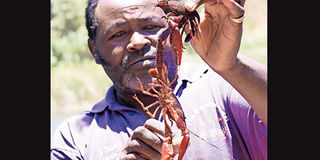Fish predator turns into source of cash

One of the group's members displays the crayfish they keep. Their main market for the crayfish is currently in Naivasha tourist hotels where it is prepared as a meal. PHOTO | JOSEPH KANYI | NMG
What you need to know:
- The creature has been feeding on fish caught in the nets they cast overnight.
- The crustaceans are often referred to as little lobsters, with the dam’s cool water providing an ideal environment for the creature.
- Using trap nets, the fishermen have been catching the crayfish and selling them in Naivasha for Sh1,000 per kilo.
- The venture has become an added moneymaking avenue as they only purchase the nets at Sh1,000 each.
For nearly two decades, members of Njeng’u Fishing and Sports Self-help Group have been fishing at a dam Nyeri County.
However, they have been frustrated by an eight-leg predator that has preying on their tilapia fish stock.
“We have been catching fish for sale for more than 20 years from this dam as it grows naturally in it,” John Mambo, the chair of the group tells Seeds of Gold.
While the dam produces big catch, the crayfish, an omnivorous water creature that feeds on other fish and plants (algae), has been their biggest trouble.
The creature has been feeding on fish caught in the nets they cast overnight.
Crayfish survives in cool waters and tropical climates and their physical anatomy resembles that of a lobster.
The crustaceans are often referred to as little lobsters, with the dam’s cool water providing an ideal environment for the creature.
“They would kill the fish caught in the nets but feed on very small bits as they are small. The rest of the catch cannot be sold because the fish starts rotting instantly,” Mambo explains.
Worse, they tangle up the nets using their claws making it impossible to catch fish.
The fishermen previously did not know how to get rid of the problem and did not know that they were sitting on gold.
Months ago, Mambo travelled to Naivasha to shop for new nets when he came across chefs cooking the crustaceans.
After the eye-opening experience, Mambo floated the idea of selling the crayfish to members of the group.
“We had someone who had agreed to buy the crayfish for Sh1,000 per kilo. So we decided to see how many we could catch,” Stephen Kariuki, the group secretary said.
Using trap nets, the fishermen have been catching the crayfish and selling them in Naivasha for Sh1,000 per kilo.
PRICEY DELICACY
“We place small pieces of fish inside the nets, which we use to lure the crayfish. Once inside the net, they are unable to crawl out due to their claw-shaped forelimbs,” explains Kariuki.
Currently, the fishermen have eight nets which trap at least 10kg of crayfish per day. After catching them, they put them in a gunny bag and immerse it in water for the buyer to collect.
“They are sold when live so we keep them in the water to prevent them from dying. This way, the crayfish continues feeding on algae and plankton inside the dam,” Mambo explains.

The members showcase some of the traps they use for harvesting the crayfish. Currently, the fishermen have eight nets which trap at least 10kg of crayfish per day. PHOTO | JOSEPH KANYI | NMG
The venture has become an added moneymaking avenue as they only purchase the nets at Sh1,000 each.
“This is their natural habitat and there is no investment we are putting in so the profit margin is very high. It also reduces our previous predator challenge,” Mambo argues.
They, however, have drafted a harvesting plan which they have incorporated with their existing fishing schedule.
“Normally, we harvest fish for six months and close for three months to avoid depletion. To balance the ecosystem, we will now harvest the crayfish during the three months,” Kariuki explains, noting they sell tilapia at Sh400 a kilo.
Their main market is currently in Naivasha tourist hotels where the crayfish is prepared as a meal.
The delicacy is quite pricey, with a plate going for as much as Sh4,000 in the hotels.
Mr David Kilo, a fisheries expert in Naivasha, said crayfish offers lucrative profits. “It is important to manage the harvesting patterns but they do not really need to take long breaks between harvesting seasons. They have an advantage due to the fact that this is their natural habitat where they do not need to control anything,” Kilo said, adding.
Naivasha is a major market for the crayfish.
****
Crayfish can also thrive in ponds
Crayfish naturally occurs in cool fresh water bodies and can be reared in ponds as well.
The crayfish exists naturally in the dam due to the fresh water from rain which drains into it. They breed naturally.
They group has a harvesting schedule where they fish after six months for three months daily.



